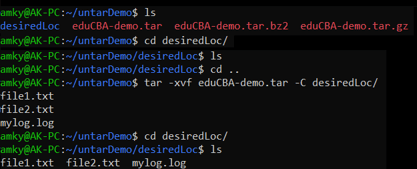

- #UNTAR TO DIRECTORY HOW TO#
- #UNTAR TO DIRECTORY FOR MAC OS#
- #UNTAR TO DIRECTORY ZIP FILE#
- #UNTAR TO DIRECTORY ARCHIVE#
- #UNTAR TO DIRECTORY WINDOWS#
Check the following tar command for better understanding.
#UNTAR TO DIRECTORY ARCHIVE#
tar archive two files: Bbear_EP_04.ac3 and Bbear_EP_05.ac3. In this example we will extract from the. The tar program also provides the possibility to extract specific files and directories. tbz2), we will simply add the -j tar switch just as so: tar -jxvf 2 -C output/uncompress Extract Only Specific Files and Directories To extract tar files compressed by this algorithm (e.g., tar.bz, tar.bz2 or. For example, if you have two files, file1.tar and file2.tar, in the same directory and you want to extract them into separate directories, you would use the following command: tar -xvf file1.tar -C /path/to/directory1 tar -xvf file2. tar -zxvf -C output/uncompress Extracting Bzip2 Compressed Filesīzip2 is another file compression program used by the tar command line utility. To untar multiple files in different directories, you can use the -C option. tgz we will have to use the -z switch as mentioned below. In this section we will be acquainted with how we can extract different compressed tar archives. Follow the example below: tar -xvf myarchive.tar -C output/untarġ directory, 6 files Extracting Compressed Tar ArchiveĪs we have mentioned before, the tar command can create and extract archive files using numerous compression algorithms such as xz, gzip, and bzip2. We can achieve that by using the -C tar switch to specify where you extract the. When you want to extract tar files to different directories you don’t have to change the directory using the cd command or by copying the tar archive to the desired directory then extract files.
#UNTAR TO DIRECTORY HOW TO#
However this article will cover only the subject of how to extract tar archives using special tar options to specify the target directory in addition, we will mention other necessary tar arguments.

Tar comes with an enormous amount of options which are and can be confusing for even experienced Linux users. This essential tool is implementing various compression algorithms such as gzip, xz, and bzip2. In other words, the tar program packs many files and folders into a single logical file for easy and fast transmission (e.g. Additionally, tar can be used to compress and decompress these archived files. tar stands for Tape ARchive, and it is used for creating and extracting archive files. Tar is a very old command line utility from the seventies.
#UNTAR TO DIRECTORY FOR MAC OS#
zip archives use Windows-style line terminators, you will need to pass the -a option to unzip in order to extract them with UNIX-style line terminators (also needed for Mac OS X). Your operating system may already have a copy of the unzip program (or similar) otherwise it may be downloaded from the Info-ZIP website. zip files on a non-Windows platform, this is possible.

If, for some reason, you wish to unpack the. Refer to the documentation provided with whichever program you choose for further instructions.
#UNTAR TO DIRECTORY ZIP FILE#
zip files, you will need to download a zip file extractor such as JustZIPIt or the Info-ZIP tools.
#UNTAR TO DIRECTORY WINDOWS#
If using a version of Windows without inbuilt support for. To extract the files within, right click on the file and select the “Extract All” option. zip file should look like a normal folder icon with a zipper on it. Most modern Windows environments already know how to unpack. If you also wish to see a list of the files as they are extracted, instead use the command tar xopft foo.tar Unpacking. tar file, say foo.tar, use the following command: tar xopf foo.tar The newly extracted files will be created in the current directory. tar filesįirst, ensure that you have a shell running and cd to the same directory as the downloaded file. If you also wish to see a list of the files as they are extracted, instead use the command gunzip -c | tar xopft - Unpacking. tar.gz file, say, use the following command: gunzip -c | tar xopf - The newly extracted files will be created in the current directory. tar.gz filesįirst, ensure that you have a shell running and cd to the same directory as the downloaded file. If you would rather follow the UNIX-style instructions below you can use the Terminal command-line application, which can be found in your Utilities folder. (Note that it may be necessary to unpack some files twice.) zip file automatically when you double-click on its icon.


 0 kommentar(er)
0 kommentar(er)
